Financial Analysis and Budgeting Techniques
VerifiedAdded on 2020/12/10
|13
|3216
|342
Report
AI Summary
This report analyzes the financial performance of Unilever Plc and compares it to its competitors. It also examines various budgeting techniques that can be used by large global companies to improve planning, control, and operational performance. The report highlights the role of technology in budgeting and forecasting.
Contribute Materials
Your contribution can guide someone’s learning journey. Share your
documents today.

Finance
Secure Best Marks with AI Grader
Need help grading? Try our AI Grader for instant feedback on your assignments.

Table of Contents
INTRODUCTION...........................................................................................................................1
PART 1............................................................................................................................................1
Presentation of the financial analysis of for 2015 and 2016 and comparison with peers
companion's performances..........................................................................................................1
PART 2............................................................................................................................................8
Critical evaluation of the budgetary techniques that can help to large global companies........8
REFERENCES..............................................................................................................................11
INTRODUCTION...........................................................................................................................1
PART 1............................................................................................................................................1
Presentation of the financial analysis of for 2015 and 2016 and comparison with peers
companion's performances..........................................................................................................1
PART 2............................................................................................................................................8
Critical evaluation of the budgetary techniques that can help to large global companies........8
REFERENCES..............................................................................................................................11
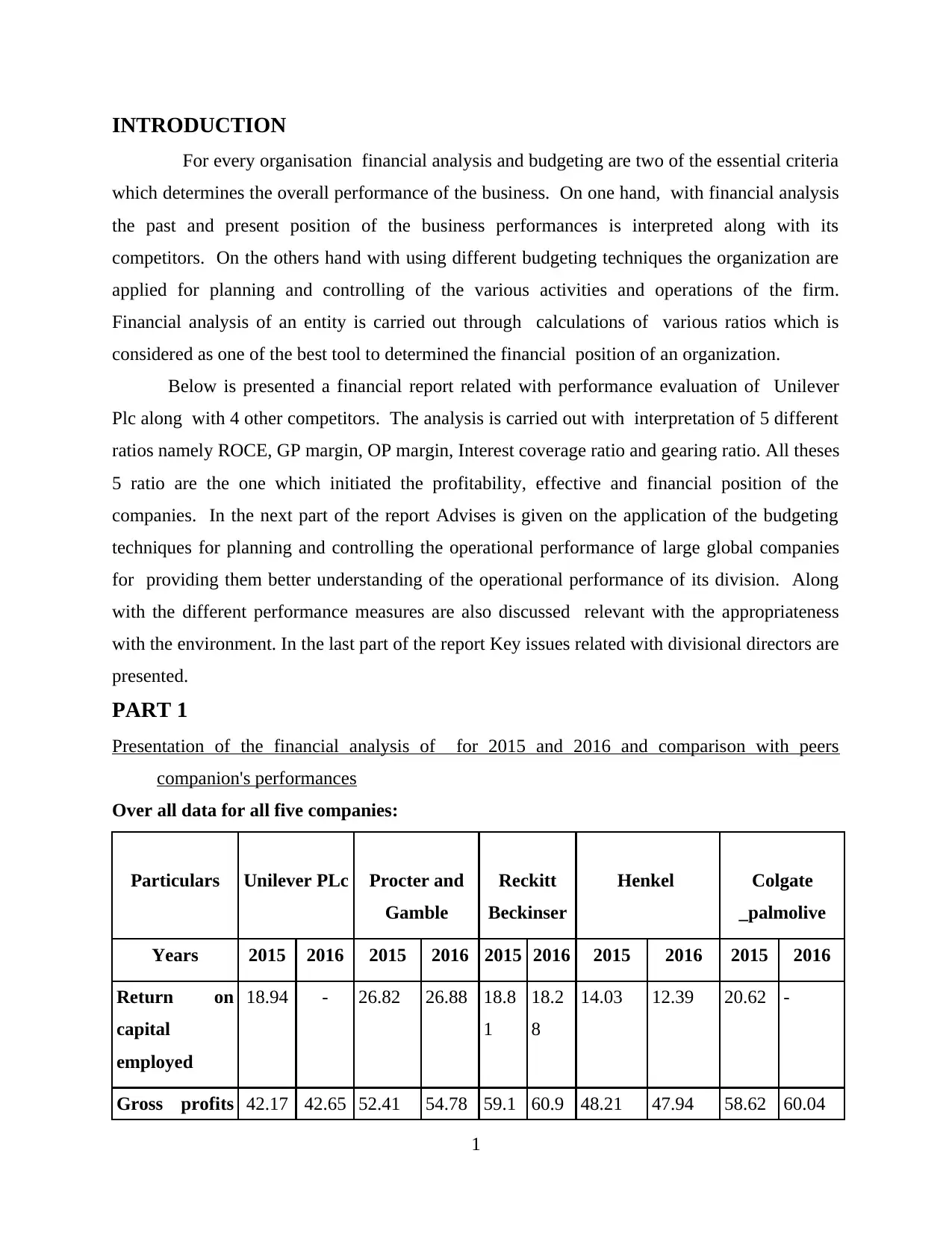
INTRODUCTION
For every organisation financial analysis and budgeting are two of the essential criteria
which determines the overall performance of the business. On one hand, with financial analysis
the past and present position of the business performances is interpreted along with its
competitors. On the others hand with using different budgeting techniques the organization are
applied for planning and controlling of the various activities and operations of the firm.
Financial analysis of an entity is carried out through calculations of various ratios which is
considered as one of the best tool to determined the financial position of an organization.
Below is presented a financial report related with performance evaluation of Unilever
Plc along with 4 other competitors. The analysis is carried out with interpretation of 5 different
ratios namely ROCE, GP margin, OP margin, Interest coverage ratio and gearing ratio. All theses
5 ratio are the one which initiated the profitability, effective and financial position of the
companies. In the next part of the report Advises is given on the application of the budgeting
techniques for planning and controlling the operational performance of large global companies
for providing them better understanding of the operational performance of its division. Along
with the different performance measures are also discussed relevant with the appropriateness
with the environment. In the last part of the report Key issues related with divisional directors are
presented.
PART 1
Presentation of the financial analysis of for 2015 and 2016 and comparison with peers
companion's performances
Over all data for all five companies:
Particulars Unilever PLc Procter and
Gamble
Reckitt
Beckinser
Henkel Colgate
_palmolive
Years 2015 2016 2015 2016 2015 2016 2015 2016 2015 2016
Return on
capital
employed
18.94 - 26.82 26.88 18.8
1
18.2
8
14.03 12.39 20.62 -
Gross profits 42.17 42.65 52.41 54.78 59.1 60.9 48.21 47.94 58.62 60.04
1
For every organisation financial analysis and budgeting are two of the essential criteria
which determines the overall performance of the business. On one hand, with financial analysis
the past and present position of the business performances is interpreted along with its
competitors. On the others hand with using different budgeting techniques the organization are
applied for planning and controlling of the various activities and operations of the firm.
Financial analysis of an entity is carried out through calculations of various ratios which is
considered as one of the best tool to determined the financial position of an organization.
Below is presented a financial report related with performance evaluation of Unilever
Plc along with 4 other competitors. The analysis is carried out with interpretation of 5 different
ratios namely ROCE, GP margin, OP margin, Interest coverage ratio and gearing ratio. All theses
5 ratio are the one which initiated the profitability, effective and financial position of the
companies. In the next part of the report Advises is given on the application of the budgeting
techniques for planning and controlling the operational performance of large global companies
for providing them better understanding of the operational performance of its division. Along
with the different performance measures are also discussed relevant with the appropriateness
with the environment. In the last part of the report Key issues related with divisional directors are
presented.
PART 1
Presentation of the financial analysis of for 2015 and 2016 and comparison with peers
companion's performances
Over all data for all five companies:
Particulars Unilever PLc Procter and
Gamble
Reckitt
Beckinser
Henkel Colgate
_palmolive
Years 2015 2016 2015 2016 2015 2016 2015 2016 2015 2016
Return on
capital
employed
18.94 - 26.82 26.88 18.8
1
18.2
8
14.03 12.39 20.62 -
Gross profits 42.17 42.65 52.41 54.78 59.1 60.9 48.21 47.94 58.62 60.04
1
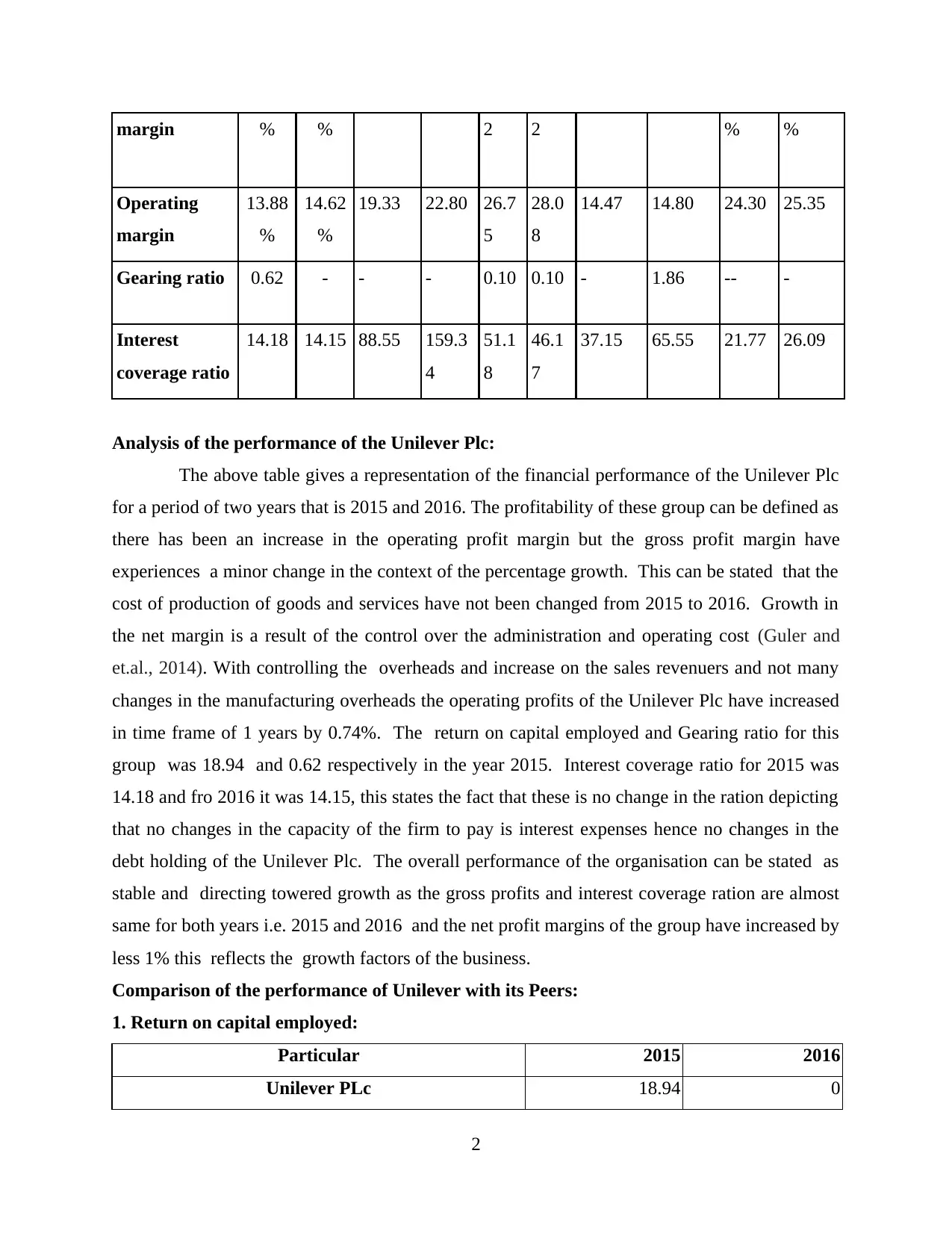
margin % % 2 2 % %
Operating
margin
13.88
%
14.62
%
19.33 22.80 26.7
5
28.0
8
14.47 14.80 24.30 25.35
Gearing ratio 0.62 - - - 0.10 0.10 - 1.86 -- -
Interest
coverage ratio
14.18 14.15 88.55 159.3
4
51.1
8
46.1
7
37.15 65.55 21.77 26.09
Analysis of the performance of the Unilever Plc:
The above table gives a representation of the financial performance of the Unilever Plc
for a period of two years that is 2015 and 2016. The profitability of these group can be defined as
there has been an increase in the operating profit margin but the gross profit margin have
experiences a minor change in the context of the percentage growth. This can be stated that the
cost of production of goods and services have not been changed from 2015 to 2016. Growth in
the net margin is a result of the control over the administration and operating cost (Guler and
et.al., 2014). With controlling the overheads and increase on the sales revenuers and not many
changes in the manufacturing overheads the operating profits of the Unilever Plc have increased
in time frame of 1 years by 0.74%. The return on capital employed and Gearing ratio for this
group was 18.94 and 0.62 respectively in the year 2015. Interest coverage ratio for 2015 was
14.18 and fro 2016 it was 14.15, this states the fact that these is no change in the ration depicting
that no changes in the capacity of the firm to pay is interest expenses hence no changes in the
debt holding of the Unilever Plc. The overall performance of the organisation can be stated as
stable and directing towered growth as the gross profits and interest coverage ration are almost
same for both years i.e. 2015 and 2016 and the net profit margins of the group have increased by
less 1% this reflects the growth factors of the business.
Comparison of the performance of Unilever with its Peers:
1. Return on capital employed:
Particular 2015 2016
Unilever PLc 18.94 0
2
Operating
margin
13.88
%
14.62
%
19.33 22.80 26.7
5
28.0
8
14.47 14.80 24.30 25.35
Gearing ratio 0.62 - - - 0.10 0.10 - 1.86 -- -
Interest
coverage ratio
14.18 14.15 88.55 159.3
4
51.1
8
46.1
7
37.15 65.55 21.77 26.09
Analysis of the performance of the Unilever Plc:
The above table gives a representation of the financial performance of the Unilever Plc
for a period of two years that is 2015 and 2016. The profitability of these group can be defined as
there has been an increase in the operating profit margin but the gross profit margin have
experiences a minor change in the context of the percentage growth. This can be stated that the
cost of production of goods and services have not been changed from 2015 to 2016. Growth in
the net margin is a result of the control over the administration and operating cost (Guler and
et.al., 2014). With controlling the overheads and increase on the sales revenuers and not many
changes in the manufacturing overheads the operating profits of the Unilever Plc have increased
in time frame of 1 years by 0.74%. The return on capital employed and Gearing ratio for this
group was 18.94 and 0.62 respectively in the year 2015. Interest coverage ratio for 2015 was
14.18 and fro 2016 it was 14.15, this states the fact that these is no change in the ration depicting
that no changes in the capacity of the firm to pay is interest expenses hence no changes in the
debt holding of the Unilever Plc. The overall performance of the organisation can be stated as
stable and directing towered growth as the gross profits and interest coverage ration are almost
same for both years i.e. 2015 and 2016 and the net profit margins of the group have increased by
less 1% this reflects the growth factors of the business.
Comparison of the performance of Unilever with its Peers:
1. Return on capital employed:
Particular 2015 2016
Unilever PLc 18.94 0
2
Secure Best Marks with AI Grader
Need help grading? Try our AI Grader for instant feedback on your assignments.
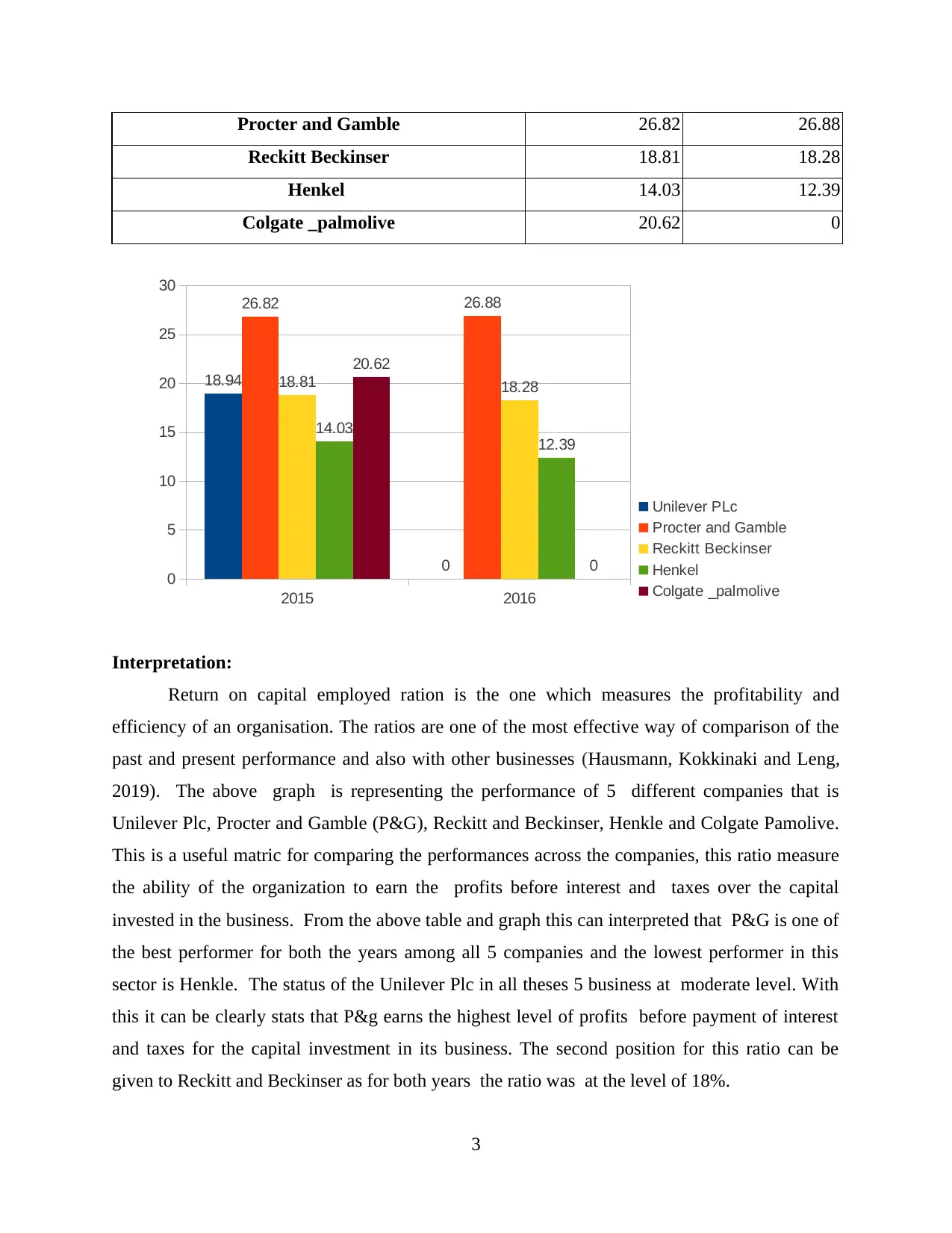
Procter and Gamble 26.82 26.88
Reckitt Beckinser 18.81 18.28
Henkel 14.03 12.39
Colgate _palmolive 20.62 0
2015 2016
0
5
10
15
20
25
30
18.94
0
26.82 26.88
18.81 18.28
14.03
12.39
20.62
0
Unilever PLc
Procter and Gamble
Reckitt Beckinser
Henkel
Colgate _palmolive
Interpretation:
Return on capital employed ration is the one which measures the profitability and
efficiency of an organisation. The ratios are one of the most effective way of comparison of the
past and present performance and also with other businesses (Hausmann, Kokkinaki and Leng,
2019). The above graph is representing the performance of 5 different companies that is
Unilever Plc, Procter and Gamble (P&G), Reckitt and Beckinser, Henkle and Colgate Pamolive.
This is a useful matric for comparing the performances across the companies, this ratio measure
the ability of the organization to earn the profits before interest and taxes over the capital
invested in the business. From the above table and graph this can interpreted that P&G is one of
the best performer for both the years among all 5 companies and the lowest performer in this
sector is Henkle. The status of the Unilever Plc in all theses 5 business at moderate level. With
this it can be clearly stats that P&g earns the highest level of profits before payment of interest
and taxes for the capital investment in its business. The second position for this ratio can be
given to Reckitt and Beckinser as for both years the ratio was at the level of 18%.
3
Reckitt Beckinser 18.81 18.28
Henkel 14.03 12.39
Colgate _palmolive 20.62 0
2015 2016
0
5
10
15
20
25
30
18.94
0
26.82 26.88
18.81 18.28
14.03
12.39
20.62
0
Unilever PLc
Procter and Gamble
Reckitt Beckinser
Henkel
Colgate _palmolive
Interpretation:
Return on capital employed ration is the one which measures the profitability and
efficiency of an organisation. The ratios are one of the most effective way of comparison of the
past and present performance and also with other businesses (Hausmann, Kokkinaki and Leng,
2019). The above graph is representing the performance of 5 different companies that is
Unilever Plc, Procter and Gamble (P&G), Reckitt and Beckinser, Henkle and Colgate Pamolive.
This is a useful matric for comparing the performances across the companies, this ratio measure
the ability of the organization to earn the profits before interest and taxes over the capital
invested in the business. From the above table and graph this can interpreted that P&G is one of
the best performer for both the years among all 5 companies and the lowest performer in this
sector is Henkle. The status of the Unilever Plc in all theses 5 business at moderate level. With
this it can be clearly stats that P&g earns the highest level of profits before payment of interest
and taxes for the capital investment in its business. The second position for this ratio can be
given to Reckitt and Beckinser as for both years the ratio was at the level of 18%.
3
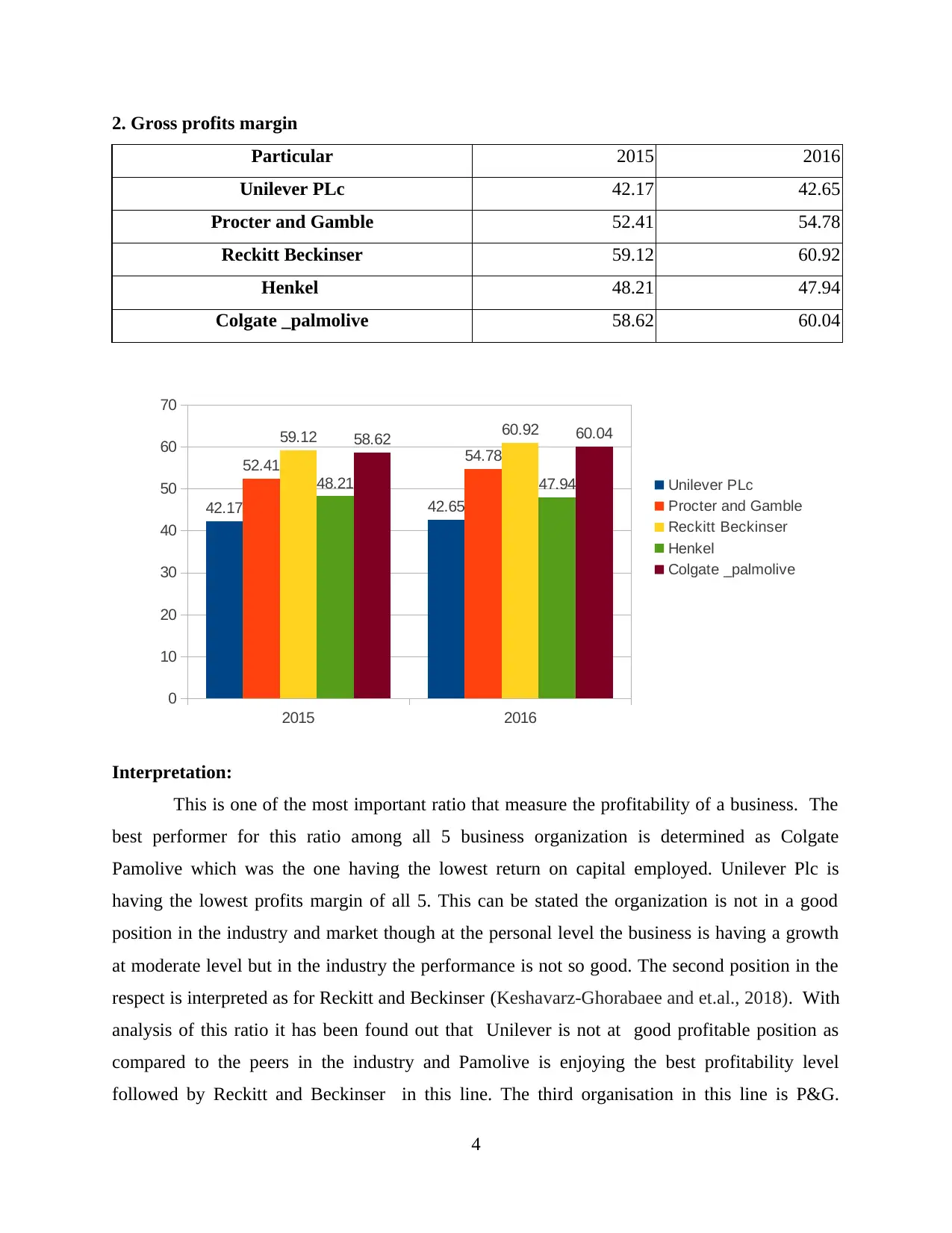
2. Gross profits margin
Particular 2015 2016
Unilever PLc 42.17 42.65
Procter and Gamble 52.41 54.78
Reckitt Beckinser 59.12 60.92
Henkel 48.21 47.94
Colgate _palmolive 58.62 60.04
Interpretation:
This is one of the most important ratio that measure the profitability of a business. The
best performer for this ratio among all 5 business organization is determined as Colgate
Pamolive which was the one having the lowest return on capital employed. Unilever Plc is
having the lowest profits margin of all 5. This can be stated the organization is not in a good
position in the industry and market though at the personal level the business is having a growth
at moderate level but in the industry the performance is not so good. The second position in the
respect is interpreted as for Reckitt and Beckinser (Keshavarz-Ghorabaee and et.al., 2018). With
analysis of this ratio it has been found out that Unilever is not at good profitable position as
compared to the peers in the industry and Pamolive is enjoying the best profitability level
followed by Reckitt and Beckinser in this line. The third organisation in this line is P&G.
4
2015 2016
0
10
20
30
40
50
60
70
42.17 42.65
52.41 54.78
59.12 60.92
48.21 47.94
58.62 60.04
Unilever PLc
Procter and Gamble
Reckitt Beckinser
Henkel
Colgate _palmolive
Particular 2015 2016
Unilever PLc 42.17 42.65
Procter and Gamble 52.41 54.78
Reckitt Beckinser 59.12 60.92
Henkel 48.21 47.94
Colgate _palmolive 58.62 60.04
Interpretation:
This is one of the most important ratio that measure the profitability of a business. The
best performer for this ratio among all 5 business organization is determined as Colgate
Pamolive which was the one having the lowest return on capital employed. Unilever Plc is
having the lowest profits margin of all 5. This can be stated the organization is not in a good
position in the industry and market though at the personal level the business is having a growth
at moderate level but in the industry the performance is not so good. The second position in the
respect is interpreted as for Reckitt and Beckinser (Keshavarz-Ghorabaee and et.al., 2018). With
analysis of this ratio it has been found out that Unilever is not at good profitable position as
compared to the peers in the industry and Pamolive is enjoying the best profitability level
followed by Reckitt and Beckinser in this line. The third organisation in this line is P&G.
4
2015 2016
0
10
20
30
40
50
60
70
42.17 42.65
52.41 54.78
59.12 60.92
48.21 47.94
58.62 60.04
Unilever PLc
Procter and Gamble
Reckitt Beckinser
Henkel
Colgate _palmolive

Another factors that has been determined from the adobe graph is that all 5 business did not
experience major change in the gross profit margin from 2015 to 2016. All are performing at
same level for both the year with minor changes in the ratio.
3. Operating margin
Particular 2015 2016
Unilever PLc 13.88 14.62
Procter and Gamble 19.33 22.8
Reckitt Beckinser 26.75 28.08
Henkel 14.47 14.8
Colgate _palmolive 24.3 25.35
Interpretation:
The above graph represent the operating margin of all 5 business organisation for a time
frame for 2 years that is 2015 and 2016. The operating margin for both the years was for the
firm P&G and in this line second is Reckitt and Beckinser. This can be stated that P&G have a
good controller over its operating expenses as compared to all other firms. While Unilever Plc is
the having the lowest ratio for both years. This can be stated that p&G and Reckitt and Beckinser
are in great competition as one is having the highest Gross profits margin and another is having
more operating margin as compared to other (Uechi and et.al., 2015). This fact is also
determined from the above graph that Unilever pls is not at all in the position of the competition
5
2015 2016
0
5
10
15
20
25
30
13.88 14.62
19.33
22.8
26.75 28.08
14.47 14.8
24.3 25.35
Unilever PLc
Procter and Gamble
Reckitt Beckinser
Henkel
Colgate _palmolive
experience major change in the gross profit margin from 2015 to 2016. All are performing at
same level for both the year with minor changes in the ratio.
3. Operating margin
Particular 2015 2016
Unilever PLc 13.88 14.62
Procter and Gamble 19.33 22.8
Reckitt Beckinser 26.75 28.08
Henkel 14.47 14.8
Colgate _palmolive 24.3 25.35
Interpretation:
The above graph represent the operating margin of all 5 business organisation for a time
frame for 2 years that is 2015 and 2016. The operating margin for both the years was for the
firm P&G and in this line second is Reckitt and Beckinser. This can be stated that P&G have a
good controller over its operating expenses as compared to all other firms. While Unilever Plc is
the having the lowest ratio for both years. This can be stated that p&G and Reckitt and Beckinser
are in great competition as one is having the highest Gross profits margin and another is having
more operating margin as compared to other (Uechi and et.al., 2015). This fact is also
determined from the above graph that Unilever pls is not at all in the position of the competition
5
2015 2016
0
5
10
15
20
25
30
13.88 14.62
19.33
22.8
26.75 28.08
14.47 14.8
24.3 25.35
Unilever PLc
Procter and Gamble
Reckitt Beckinser
Henkel
Colgate _palmolive
Paraphrase This Document
Need a fresh take? Get an instant paraphrase of this document with our AI Paraphraser

with these two firms rather t is the organization with the lower most ration for operational profit
margin. In this line Henkel is also not performing well among all the 5 businesses. With this it
can be stated that Unilever and Henkle are the two business organisation with the lower most
gross profit ratio.
4. Gearing ratio:
Particular 2015 2016
Unilever PLc 0.62 0
Procter and Gamble 0 0
Reckitt Beckinser 0.1 0.1
Henkel 0 1.86
Colgate _palmolive 0 0
Interpretation:
The gearing ratio depicts the financial leverage of the firm with the degree to which its
operations are funded by the equity capital versus the credit financing. Higher gearing ratios
indicate a company has a higher degree of financial leverage and is more susceptible to
downturns in the economy and the business cycle. Companies with lower gearing ratio
calculations have more equity to rely upon as financing is needed. The data is available for only
two firms only and this can be stated that for both the years the Reckitt and Beckinser ratio is
6
2015 2016
0
0.2
0.4
0.6
0.8
1
1.2
1.4
1.6
1.8
2
Unilever PLc
Procter and Gamble
Reckitt Beckinser
Henkel
Colgate _palmolive
margin. In this line Henkel is also not performing well among all the 5 businesses. With this it
can be stated that Unilever and Henkle are the two business organisation with the lower most
gross profit ratio.
4. Gearing ratio:
Particular 2015 2016
Unilever PLc 0.62 0
Procter and Gamble 0 0
Reckitt Beckinser 0.1 0.1
Henkel 0 1.86
Colgate _palmolive 0 0
Interpretation:
The gearing ratio depicts the financial leverage of the firm with the degree to which its
operations are funded by the equity capital versus the credit financing. Higher gearing ratios
indicate a company has a higher degree of financial leverage and is more susceptible to
downturns in the economy and the business cycle. Companies with lower gearing ratio
calculations have more equity to rely upon as financing is needed. The data is available for only
two firms only and this can be stated that for both the years the Reckitt and Beckinser ratio is
6
2015 2016
0
0.2
0.4
0.6
0.8
1
1.2
1.4
1.6
1.8
2
Unilever PLc
Procter and Gamble
Reckitt Beckinser
Henkel
Colgate _palmolive

0.10 times which means the business is relying more on the equity funding for its financial
needs rather on the debt sources (Zolfani, Yazdani and Zavadskas, 2018)(. The ratio for
Unilever for 2015 was 0.62, which means it relies to a minimum level to funds its business
operation on the debt funds rather its has sufficient funds to carry on its daily activities of the
firm. From the above graph it can be interpreted that Hankle do not have a good gearing ratio
which was at 1.86 times in 2016 means it takes more funds from the debt funding to carry out
the day to day business operations.
5. Interest coverage ratio:
Particular 2015 2016
Unilever PLc 14.18 14.15
Procter and Gamble 88.55 159.34
Reckitt Beckinser 51.18 37.15
Henkel 37.15 65.55
Colgate _palmolive 21.77 26.09
Interpretation:
Interest coverage ratio is the one through which an organisation determines the ability of
the organisation to pay the interest expenses on the outstanding debts. This ratio is calculated by
diving the earning before interest and tax by the interest expense of the business. This give the
ratio in times which means that how many times the interest expenses can be paid by the firm
7
Unilever PLc
Procter and Gamble
Reckitt Beckinser
Henkel
Colgate _palmolive
2015 2016
0
20
40
60
80
100
120
140
160
180
14.18 14.15
88.55
159.34
51.18
37.1537.15
65.55
21.77 26.09
needs rather on the debt sources (Zolfani, Yazdani and Zavadskas, 2018)(. The ratio for
Unilever for 2015 was 0.62, which means it relies to a minimum level to funds its business
operation on the debt funds rather its has sufficient funds to carry on its daily activities of the
firm. From the above graph it can be interpreted that Hankle do not have a good gearing ratio
which was at 1.86 times in 2016 means it takes more funds from the debt funding to carry out
the day to day business operations.
5. Interest coverage ratio:
Particular 2015 2016
Unilever PLc 14.18 14.15
Procter and Gamble 88.55 159.34
Reckitt Beckinser 51.18 37.15
Henkel 37.15 65.55
Colgate _palmolive 21.77 26.09
Interpretation:
Interest coverage ratio is the one through which an organisation determines the ability of
the organisation to pay the interest expenses on the outstanding debts. This ratio is calculated by
diving the earning before interest and tax by the interest expense of the business. This give the
ratio in times which means that how many times the interest expenses can be paid by the firm
7
Unilever PLc
Procter and Gamble
Reckitt Beckinser
Henkel
Colgate _palmolive
2015 2016
0
20
40
60
80
100
120
140
160
180
14.18 14.15
88.55
159.34
51.18
37.1537.15
65.55
21.77 26.09
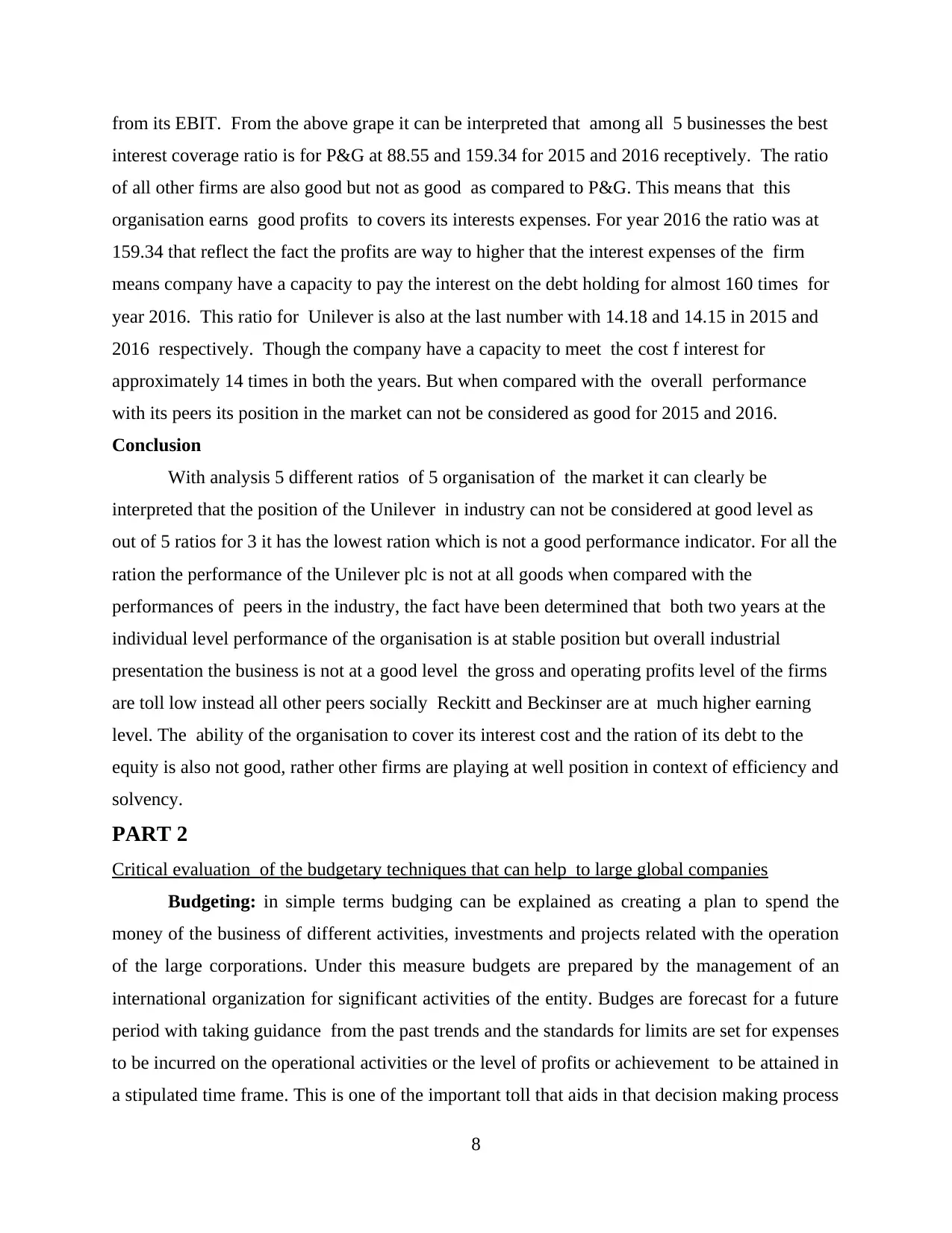
from its EBIT. From the above grape it can be interpreted that among all 5 businesses the best
interest coverage ratio is for P&G at 88.55 and 159.34 for 2015 and 2016 receptively. The ratio
of all other firms are also good but not as good as compared to P&G. This means that this
organisation earns good profits to covers its interests expenses. For year 2016 the ratio was at
159.34 that reflect the fact the profits are way to higher that the interest expenses of the firm
means company have a capacity to pay the interest on the debt holding for almost 160 times for
year 2016. This ratio for Unilever is also at the last number with 14.18 and 14.15 in 2015 and
2016 respectively. Though the company have a capacity to meet the cost f interest for
approximately 14 times in both the years. But when compared with the overall performance
with its peers its position in the market can not be considered as good for 2015 and 2016.
Conclusion
With analysis 5 different ratios of 5 organisation of the market it can clearly be
interpreted that the position of the Unilever in industry can not be considered at good level as
out of 5 ratios for 3 it has the lowest ration which is not a good performance indicator. For all the
ration the performance of the Unilever plc is not at all goods when compared with the
performances of peers in the industry, the fact have been determined that both two years at the
individual level performance of the organisation is at stable position but overall industrial
presentation the business is not at a good level the gross and operating profits level of the firms
are toll low instead all other peers socially Reckitt and Beckinser are at much higher earning
level. The ability of the organisation to cover its interest cost and the ration of its debt to the
equity is also not good, rather other firms are playing at well position in context of efficiency and
solvency.
PART 2
Critical evaluation of the budgetary techniques that can help to large global companies
Budgeting: in simple terms budging can be explained as creating a plan to spend the
money of the business of different activities, investments and projects related with the operation
of the large corporations. Under this measure budgets are prepared by the management of an
international organization for significant activities of the entity. Budges are forecast for a future
period with taking guidance from the past trends and the standards for limits are set for expenses
to be incurred on the operational activities or the level of profits or achievement to be attained in
a stipulated time frame. This is one of the important toll that aids in that decision making process
8
interest coverage ratio is for P&G at 88.55 and 159.34 for 2015 and 2016 receptively. The ratio
of all other firms are also good but not as good as compared to P&G. This means that this
organisation earns good profits to covers its interests expenses. For year 2016 the ratio was at
159.34 that reflect the fact the profits are way to higher that the interest expenses of the firm
means company have a capacity to pay the interest on the debt holding for almost 160 times for
year 2016. This ratio for Unilever is also at the last number with 14.18 and 14.15 in 2015 and
2016 respectively. Though the company have a capacity to meet the cost f interest for
approximately 14 times in both the years. But when compared with the overall performance
with its peers its position in the market can not be considered as good for 2015 and 2016.
Conclusion
With analysis 5 different ratios of 5 organisation of the market it can clearly be
interpreted that the position of the Unilever in industry can not be considered at good level as
out of 5 ratios for 3 it has the lowest ration which is not a good performance indicator. For all the
ration the performance of the Unilever plc is not at all goods when compared with the
performances of peers in the industry, the fact have been determined that both two years at the
individual level performance of the organisation is at stable position but overall industrial
presentation the business is not at a good level the gross and operating profits level of the firms
are toll low instead all other peers socially Reckitt and Beckinser are at much higher earning
level. The ability of the organisation to cover its interest cost and the ration of its debt to the
equity is also not good, rather other firms are playing at well position in context of efficiency and
solvency.
PART 2
Critical evaluation of the budgetary techniques that can help to large global companies
Budgeting: in simple terms budging can be explained as creating a plan to spend the
money of the business of different activities, investments and projects related with the operation
of the large corporations. Under this measure budgets are prepared by the management of an
international organization for significant activities of the entity. Budges are forecast for a future
period with taking guidance from the past trends and the standards for limits are set for expenses
to be incurred on the operational activities or the level of profits or achievement to be attained in
a stipulated time frame. This is one of the important toll that aids in that decision making process
8
Secure Best Marks with AI Grader
Need help grading? Try our AI Grader for instant feedback on your assignments.
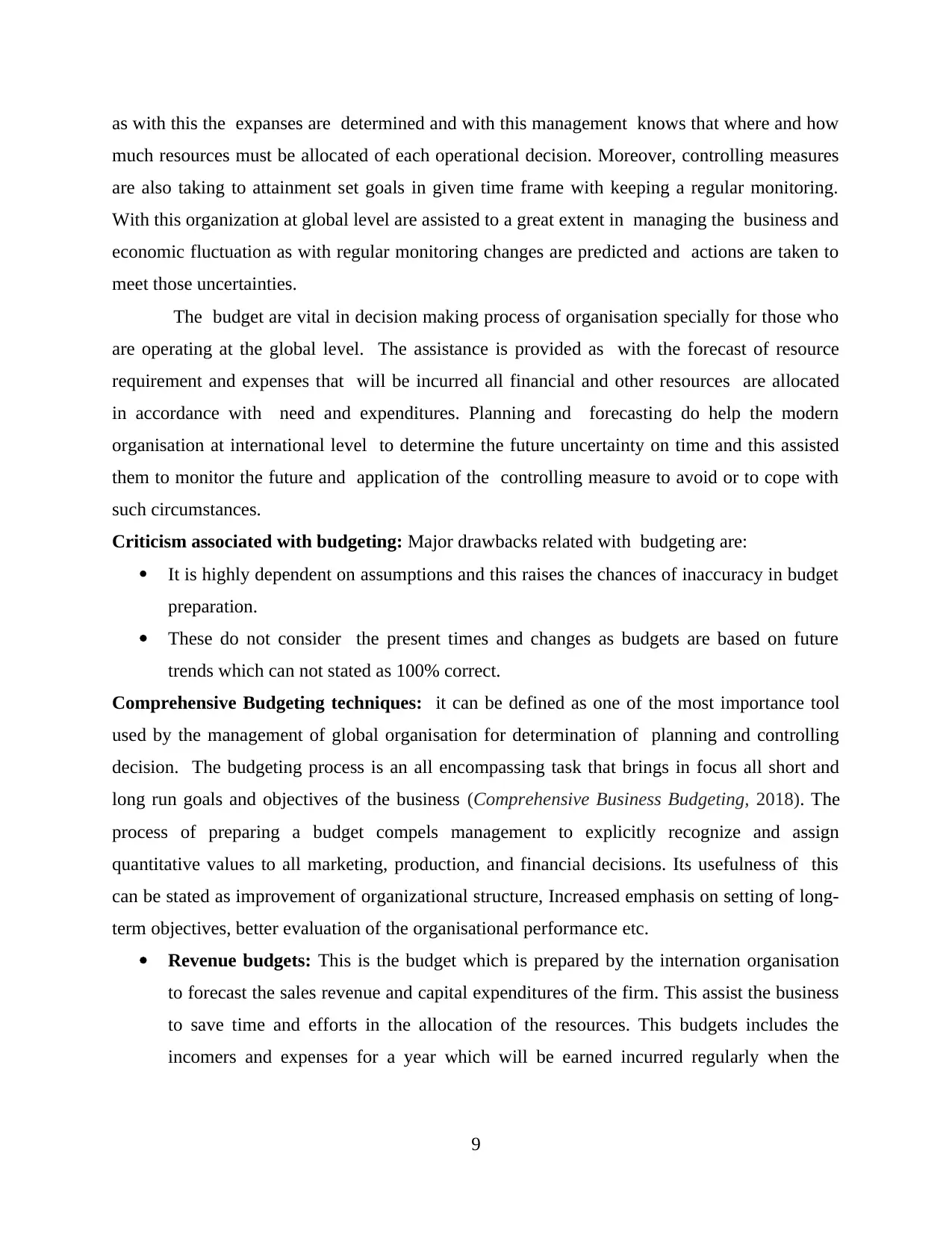
as with this the expanses are determined and with this management knows that where and how
much resources must be allocated of each operational decision. Moreover, controlling measures
are also taking to attainment set goals in given time frame with keeping a regular monitoring.
With this organization at global level are assisted to a great extent in managing the business and
economic fluctuation as with regular monitoring changes are predicted and actions are taken to
meet those uncertainties.
The budget are vital in decision making process of organisation specially for those who
are operating at the global level. The assistance is provided as with the forecast of resource
requirement and expenses that will be incurred all financial and other resources are allocated
in accordance with need and expenditures. Planning and forecasting do help the modern
organisation at international level to determine the future uncertainty on time and this assisted
them to monitor the future and application of the controlling measure to avoid or to cope with
such circumstances.
Criticism associated with budgeting: Major drawbacks related with budgeting are:
It is highly dependent on assumptions and this raises the chances of inaccuracy in budget
preparation.
These do not consider the present times and changes as budgets are based on future
trends which can not stated as 100% correct.
Comprehensive Budgeting techniques: it can be defined as one of the most importance tool
used by the management of global organisation for determination of planning and controlling
decision. The budgeting process is an all encompassing task that brings in focus all short and
long run goals and objectives of the business (Comprehensive Business Budgeting, 2018). The
process of preparing a budget compels management to explicitly recognize and assign
quantitative values to all marketing, production, and financial decisions. Its usefulness of this
can be stated as improvement of organizational structure, Increased emphasis on setting of long-
term objectives, better evaluation of the organisational performance etc.
Revenue budgets: This is the budget which is prepared by the internation organisation
to forecast the sales revenue and capital expenditures of the firm. This assist the business
to save time and efforts in the allocation of the resources. This budgets includes the
incomers and expenses for a year which will be earned incurred regularly when the
9
much resources must be allocated of each operational decision. Moreover, controlling measures
are also taking to attainment set goals in given time frame with keeping a regular monitoring.
With this organization at global level are assisted to a great extent in managing the business and
economic fluctuation as with regular monitoring changes are predicted and actions are taken to
meet those uncertainties.
The budget are vital in decision making process of organisation specially for those who
are operating at the global level. The assistance is provided as with the forecast of resource
requirement and expenses that will be incurred all financial and other resources are allocated
in accordance with need and expenditures. Planning and forecasting do help the modern
organisation at international level to determine the future uncertainty on time and this assisted
them to monitor the future and application of the controlling measure to avoid or to cope with
such circumstances.
Criticism associated with budgeting: Major drawbacks related with budgeting are:
It is highly dependent on assumptions and this raises the chances of inaccuracy in budget
preparation.
These do not consider the present times and changes as budgets are based on future
trends which can not stated as 100% correct.
Comprehensive Budgeting techniques: it can be defined as one of the most importance tool
used by the management of global organisation for determination of planning and controlling
decision. The budgeting process is an all encompassing task that brings in focus all short and
long run goals and objectives of the business (Comprehensive Business Budgeting, 2018). The
process of preparing a budget compels management to explicitly recognize and assign
quantitative values to all marketing, production, and financial decisions. Its usefulness of this
can be stated as improvement of organizational structure, Increased emphasis on setting of long-
term objectives, better evaluation of the organisational performance etc.
Revenue budgets: This is the budget which is prepared by the internation organisation
to forecast the sales revenue and capital expenditures of the firm. This assist the business
to save time and efforts in the allocation of the resources. This budgets includes the
incomers and expenses for a year which will be earned incurred regularly when the
9

business operations are being carried out. The sales are estimated from all the business
establishment around the globe dan in accordance with it resources are being allocated.
Activity based budgets: in this method budgets are prepared for the using the cost of
separate activities after taking into consideration the overheads cost of overall
operations of the international organization (Activity Based Budgeting, 2018). With this,
budgets more transparency in the budging system is provided. In which revenues
generated from instructional and research activities are allocated directly to the unit
responsible for the activity. The budges are prepared after searching into efficiency in
the significant business operations and then budgets are developed based on those
activities.
Zero based Budgeting: this is a method in which all budgets are prepared from the zero
base, this means that all the expanses in the budgets must be justifies for each new
period. Each and every function of the operational division are analysed for its
requirements and costs. This type of budgets are more flexible, focus on operational and
lower costs. In this, budgets no old trends of cost and expenses are taking into account
rather they are prepared for all new period with base as Zero. All the resource needs and
expenses are determined for each new period.
Capital budgeting: this can be defined as that techniques which is used by international
organisation before making an investment or purchase decision. The corporation at global level
remain depended on this when making capital expenditures. The decisions that are made on the
basis of outcomes given by different techniques of capital budgeting includes determination of
the projects such as deployment of smart technologies, acquisitions, purchase of land, building,
and machinery, investment in R&D, innovations etc.
Beyond budgeting: this can be defined as a principle under which the global
corporations are needed to go beyond budgeting because of inherent fleas in the budging.
Beyond command-and-control toward a management model that is more empowered and
adaptive (Beyond budgeting, 2018). This is a new concept in the budging process where the
management is required to go beyond the budgeting and rethinking how to manage organizations
activities at global level. s
Role of Technology in budgeting, planning and Forecasting: Technology is a big part
of every organisation specially for those operating at global lever as with the advance technology
10
establishment around the globe dan in accordance with it resources are being allocated.
Activity based budgets: in this method budgets are prepared for the using the cost of
separate activities after taking into consideration the overheads cost of overall
operations of the international organization (Activity Based Budgeting, 2018). With this,
budgets more transparency in the budging system is provided. In which revenues
generated from instructional and research activities are allocated directly to the unit
responsible for the activity. The budges are prepared after searching into efficiency in
the significant business operations and then budgets are developed based on those
activities.
Zero based Budgeting: this is a method in which all budgets are prepared from the zero
base, this means that all the expanses in the budgets must be justifies for each new
period. Each and every function of the operational division are analysed for its
requirements and costs. This type of budgets are more flexible, focus on operational and
lower costs. In this, budgets no old trends of cost and expenses are taking into account
rather they are prepared for all new period with base as Zero. All the resource needs and
expenses are determined for each new period.
Capital budgeting: this can be defined as that techniques which is used by international
organisation before making an investment or purchase decision. The corporation at global level
remain depended on this when making capital expenditures. The decisions that are made on the
basis of outcomes given by different techniques of capital budgeting includes determination of
the projects such as deployment of smart technologies, acquisitions, purchase of land, building,
and machinery, investment in R&D, innovations etc.
Beyond budgeting: this can be defined as a principle under which the global
corporations are needed to go beyond budgeting because of inherent fleas in the budging.
Beyond command-and-control toward a management model that is more empowered and
adaptive (Beyond budgeting, 2018). This is a new concept in the budging process where the
management is required to go beyond the budgeting and rethinking how to manage organizations
activities at global level. s
Role of Technology in budgeting, planning and Forecasting: Technology is a big part
of every organisation specially for those operating at global lever as with the advance technology
10
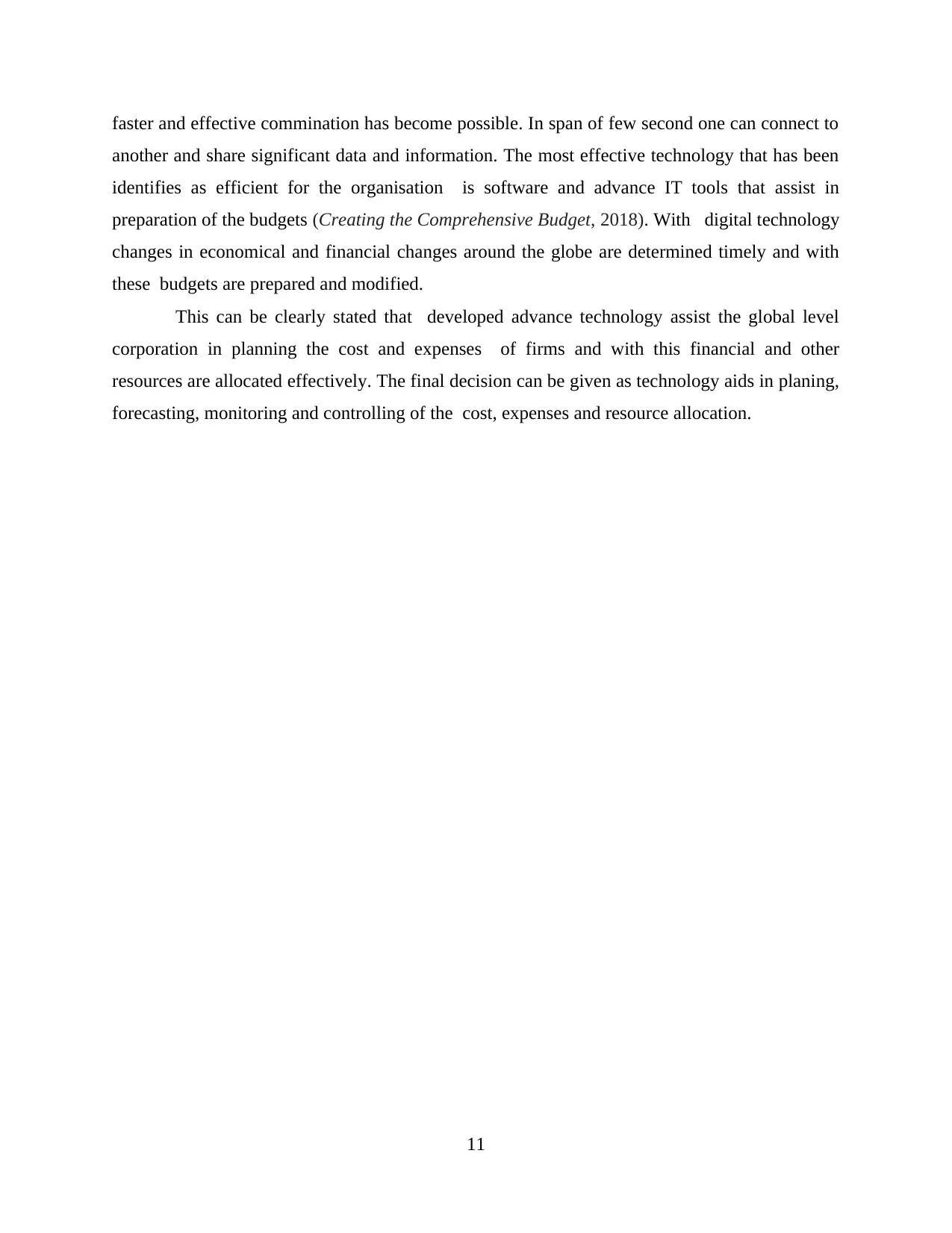
faster and effective commination has become possible. In span of few second one can connect to
another and share significant data and information. The most effective technology that has been
identifies as efficient for the organisation is software and advance IT tools that assist in
preparation of the budgets (Creating the Comprehensive Budget, 2018). With digital technology
changes in economical and financial changes around the globe are determined timely and with
these budgets are prepared and modified.
This can be clearly stated that developed advance technology assist the global level
corporation in planning the cost and expenses of firms and with this financial and other
resources are allocated effectively. The final decision can be given as technology aids in planing,
forecasting, monitoring and controlling of the cost, expenses and resource allocation.
11
another and share significant data and information. The most effective technology that has been
identifies as efficient for the organisation is software and advance IT tools that assist in
preparation of the budgets (Creating the Comprehensive Budget, 2018). With digital technology
changes in economical and financial changes around the globe are determined timely and with
these budgets are prepared and modified.
This can be clearly stated that developed advance technology assist the global level
corporation in planning the cost and expenses of firms and with this financial and other
resources are allocated effectively. The final decision can be given as technology aids in planing,
forecasting, monitoring and controlling of the cost, expenses and resource allocation.
11
1 out of 13
Related Documents
Your All-in-One AI-Powered Toolkit for Academic Success.
+13062052269
info@desklib.com
Available 24*7 on WhatsApp / Email
![[object Object]](/_next/static/media/star-bottom.7253800d.svg)
Unlock your academic potential
© 2024 | Zucol Services PVT LTD | All rights reserved.





![[PDF] Financial Statements Analysis](/_next/image/?url=https%3A%2F%2Fdesklib.com%2Fmedia%2Fimages%2Ffu%2F951ed62cc8c04e2c9ce9705c8660133a.jpg&w=256&q=75)